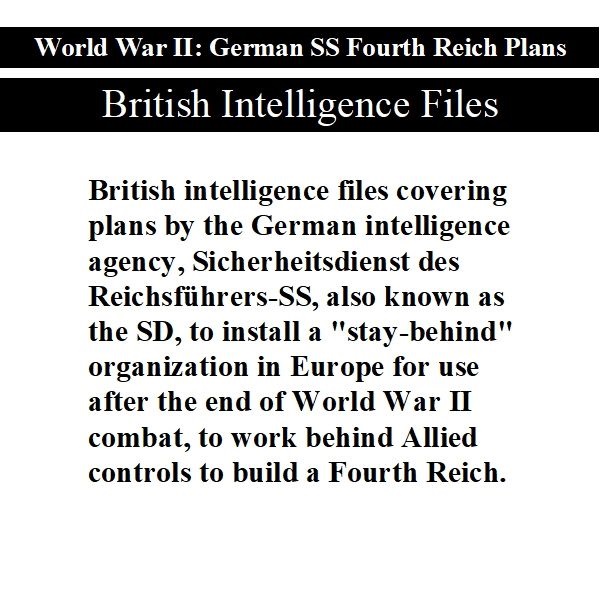
World War II: German SS Fourth Reich Plans – British Intelligence Files
$12.50
Description
Post-War Nazi Plans: Fourth Reich and Intelligence Networks
Timeline of Main Events (Based on Provided Sources)
Pre-World War II:
- 1923: Arthur Moeller van den Bruck publishes “Das Dritte Reich,” coining the term “Third Reich” and defining the historical “First” and “Second” Reichs.
- December 14, 1938: Olivier Mordrelle is convicted in France for an “attack on the nation’s unity” and receives a one-year suspended sentence.
- 1939: Olivier Mordrelle is recruited by the German military intelligence organization Abwehr.
World War II Era:
- May 1940: Olivier Mordrelle is condemned to death in absentia by a French military tribunal for his activities in the Breton Separatist movement. Following the German occupation, he returns to France as a collaborator but later goes to Germany.
- During WWII: The Sicherheitsdienst des Reichsführers-SS (SD), the intelligence wing of the SS and Nazi Party, operates. The Abwehr, the German military intelligence agency, also operates until its abolishment by Hitler in 1944. Some Breton separatists, including Olivier Mordrelle, collaborate with the Germans seeking independence from France.
- November 1944 – November 1949: British intelligence (MI5) compiles files (SF52-4-16) containing indications of the German Intelligence Service (G.I.S.) planning for continued activity after the war, including the establishment of a “stay-behind” organization to build a Fourth Reich.
- November 20, 1944 – May 2, 1946: British intelligence (MI5) compiles files (PF 602431) focusing on Olivier Marie Joseph Mordrelle and his involvement with German intelligence and post-war plans.
- April 1945: A captured German directive on guerrilla warfare urges agents to work behind enemy lines for reconnaissance, espionage, and sabotage.
- April 1945: Olivier Mordrelle attends a conference in Deisenhofen near Munich, presided over by an SS Obergruppenführer, where post-war plans to promote unrest and build a Fourth Reich are discussed. Participants are told about funds planted in South America (mainly Argentina) and trustworthy bankers sent to Spain and Switzerland. Agents are instructed to maintain a low profile before organizing “national movements” to destabilize the Allies’ post-war efforts. The SD gives Mordrelle the mission to promote unrest and incite civil war in France to facilitate the emergence of a Fourth Reich.
- June 1945: Reports indicate that the SD is preparing to continue its work through the Reichspost (German postal system), with willing postal employees being trained for SD tasks.
- May 1945: Olivier Mordrelle is captured by Allied forces in Bolzano, Italy. During interrogation, he reveals details about Nazi post-war plans to create “world disorder” leading to a Fourth Reich.
- Post-War (circa 1945-1949): British intelligence investigates and documents various indications of German intelligence efforts to regroup, reorganize, recruit new agents, and establish a “stay-behind” organization. Plans include a post-war Abwehr based in Switzerland using a powdered milk factory as a cover. The aim is to hinder the Allies’ post-war tasks and sow discord between the US and the Soviet Union. Cover organizations like local tourist offices and libraries are considered.
- March 11, 1946: Olivier Mordrelle escapes from Allied detention in Rome.
Post-War Analysis:
- Summer 2000: The CIA journal “Studies in Intelligence” publishes an article titled “The OSS and Project SAFEHAVEN, Tracking Nazi Gold.” The article details the OSS’s efforts to prevent Nazi leaders from secretly transferring industrial and fiscal capital to neutral countries to avoid confiscation and reparations, fearing this could provide a base for a resurgent Fourth Reich within 20 years.
Cast of Characters and Brief Bios
- Arthur Moeller van den Bruck: A German historian and writer who coined the term “Third Reich” in his 1923 book “Das Dritte Reich.” He defined the historical German empires as the First and Second Reichs and envisioned the Third Reich as an ideal state encompassing all German peoples. His terminology was later adopted by the Nazi regime to legitimize their rule.
- Heinrich von Berseviczy: A German intelligence official (likely within the SD or Abwehr). He was interrogated by Allied forces after the war, and his testimony suggested that surviving members of German intelligence were attempting to regroup and reorganize, including recruiting new agents for post-war activities.
- Bruno Nikoll: A German intelligence officer who was interrogated by Allied forces. His statements indicated that German intelligence was already planning for the “rebirth of Germany” and working “usefully” with the primary goals of making the Allies’ post-war tasks difficult and fostering distrust between the Americans and the Russians.
- Julius Hagemann: An individual whose interrogation report mentioned the “Friedensorganisation,” a post-war plan of the Abwehr. This suggests he was likely involved in or had knowledge of the Abwehr’s contingency planning for the period after the war.
- Olivier Marie Joseph Mordrelle (Olier Mordrel): A Breton separatist and founder of the Breton National Party. He sought independence for Brittany from France. Before the war, he was convicted in France for activities against national unity. He was recruited by the German Abwehr in 1939 and condemned to death in absentia by a French military tribunal in 1940. He collaborated with the German occupation government and was later trained by the SD as a saboteur. In April 1945, the SD tasked him with promoting unrest in France to facilitate the rise of a Fourth Reich. He was captured by Allied forces in May 1945 and provided details of Nazi post-war plans during interrogation. He escaped from Allied detention in March 1946.
- Adolf Hitler: The dictator of Nazi Germany and leader of the Nazi Party. While not directly mentioned in planning the “Fourth Reich” in these excerpts (as the focus is post-defeat), his regime and its goals were the foundation for the hypothetical future Reich. He abolished the Abwehr in 1944.
- Obergruppenführer (unnamed): A high-ranking SS officer (a general) who presided over a conference in Deisenhofen in April 1945 attended by Olivier Mordrelle and representatives from countries west of Germany. This officer outlined plans for post-war unrest and the eventual rise of a Fourth Reich, detailing the placement of funds in South America and bankers in neutral countries.
- Donald P. Steury: A CIA Officer in Residence at the University of Southern California who wrote the article “The OSS and Project SAFEHAVEN, Tracking Nazi Gold” for the CIA journal “Studies in Intelligence.” His article provides historical context on the Allied fears of a Nazi resurgence through hidden assets.
World War II: German SS Fourth Reich Plans – British Intelligence Files
168 pages of British intelligence files covering plans by the German intelligence agency, Sicherheitsdienst des Reichsführers-SS, also known as the SD, to install a “stay-behind” organization in Europe for use after the end of World War II combat, to work behind Allied controls to build a Fourth Reich.
The Sicherheitsdienst, which translates into English as Security Service, was the intelligence wing of the SS and the Nazi Party during World War II. The SD was considered a sister organization of the Gestapo.
The Fourth Reich (German: Viertes Reich) is a hypothetical future German Reich that is the successor to the Third Reich (1933–1945).
The term “Third Reich” was coined by Arthur Moeller van den Bruck in his 1923 book Das Dritte Reich. He defined the Holy Roman Empire (962–1806) as the “First Reich”, and the German Empire (1871–1918) as the “Second Reich”, while the “Third Reich” was an ideal state including all German peoples, including Austria. In the modern context the term refers to Nazi Germany. It was used by the Nazis to legitimize their regime as a successor state to the retroactively-renamed First and Second Reichs.
DOCUMENTS IN THIS SET
MI5 FILE SF52-4-16
This 78-page file, not released by the British Government until September 2011, was titled, “MISCELLANEOUS INDICATIONS OF G.I.S. POST·WAR PLANS FOR CONTINUED ACTIVITY.”
This set of reports dating from November 1944 to November 1949 contains various indications that the German Intelligence Service (G.I.S) had plans for continued activity despite defeat, after the end of World War II.
The file includes reports and assessments of the Sicherheitsdienst (SD) attempts to install a “stay-behind” organization in Europe for use behind Allied lines, after the cessation of hostilities, to build a Fourth Reich. The material includes a report on the interrogation of German intelligence official Heinrich von Berseviczy, which suggests that the survivors of the German Intelligence Service were attempting to regroup and reorganize, including the recruitment of new agents.
Plans included a postwar Abwehr. The Abwehr was the German military intelligence agency abolished by Adolf Hitler in 1944. The new Abwehr was to be based in a powdered milk factory in Switzerland, which had the “ostensible purpose of feeding undernourished German children after the war”.
A MI5 memo based on the interrogation of German intelligence officer Bruno Nikoll states that, “They were planning the rebirth of Germany and were already beginning to work ‘usefully'”. The main purpose was to “make the allies post-war task as hard as possible,” and to “ferment distrust between Americans and Russians”. Various institutions would serve as a cover for agents including local tourist offices and libraries.
Highlights from this collection of documents include information concerning:
A captured German directive on guerrilla warfare dated April 1945, urging agents to work behind enemy lines in reconnaissance, espionage and sabotage.
An extract from a report of the interrogation of Juius Hagemann, mentioning the “Friedensorganisation” post war plan of the Abwehr.
A June 1945 report that various sources indicated that the SD was preparing to continue its work through the Reichspost, the German postal system. The report says that postal employees willing to do SD work were being trained.
MI5 FILE PF 602431
This 86-page file, not released by the British Government until April 2011, was titled, “MORDRELLE.OLIVIER MARIE JOSEPH.” This set of documents, dating from November 20, 1944 to May 2, 1946, covers Olivier Marie Joseph Mordrelle, also known as Olier Mordrel, the Breton language version of Olivier Mordrelle. Mordrelle was a Breton separatist who founded the Breton National Party. The Bretons are an ethnic group of Celtic descendants located in the region of Brittany in France. During World War II some Bretons seeking independence from France became pro-German.
An MI5 report describes him as a, “petty political agitator whose efforts to create an independent BRITTANY were treated too indulgently by the French before the outbreak of war.”
On December 14, 1938, Mordrelle was convicted in France for an “attack on the nation’s unity” and given a one year suspended sentence. In 1939 Mordelle was recruited by the German military intelligence organization Abwer. In May 1940, Mordrelle was condemned to death in absentia by a French military tribunal for his activities in the Breton Separatist movement. After the establishment of a German occupation government, Mordrelle returned to France as a collaborator, but later returned to Germany.
The Sicherheitsdienst (SD) trained him as a saboteur. In April 1945, the mission given to him by the SD was to promote unrest, with the goal of starting a civil war in France, from which a Fourth Reich would emerge.
Mordrelle was captured by Allied forces in Bolzano, Italy in May 1945. During interrogation, he related details about Nazi post-war plans to create “world disorder” that would result in the rise of a Fourth Reich.
Mordrelle told his handlers that he had attended a conference in Deisenhofen near Munich in April 1945. He said that the meeting was presided over by an Obergruppenfuehrer in full SS uniform, comprising 15 representatives from countries west of Germany. Mordrelle said that plans to promote post-war unrest were discussed. At the meeting it was said that ample funds had been planted in South America (mainly Argentina) and trustworthy bankers had been sent to live in Spain and Switzerland. The agents were instructed to keep a low profile after the war before organizing “national movements” to stir up unrest and make the Allies’ post-war task as difficult as possible, so that the Nazi party could reappear in a suitable disguise and build up a Fourth Reich.
Much of the file contains details given by Mordelle of connections between Breton separatists and Irish Nationalists and connections between Germany and Irish Nationalists. The file contains information given by Mordrelle on German intelligence activities in Ireland.
On March 11, 1946 Mordelle escaped from allied detention in Rome.
CIA HISTORY OF THE OSS AND PROJECT SAFEHAVEN
In addition to the 168 Pages described above, is a 16-page article from the Summer 2000 issue of the CIA journal, “Studies in Intelligence” titled, “The OSS and Project SAFEHAVEN, Tracking Nazi Gold.”
This article was written by Donald P. Steury, who at the time was a CIA Officer in Residence at the University of Southern California. The article recounts the OSS role (SI–Secret Intelligence and X-2–Counterintelligence) in support of US policy to track, locate, and prevent Nazi postwar control of Germany’s gold and other valuable assets in neutral countries as an Allied victory approached. The overriding goal of SAFEHAVEN was to make it impossible for Germany to start another war.
Steury wrote, “The fear was that the German political and economic leadership, sensing, defeat, would act to transfer secretly blocs of industrial and fiscal capital to neutral countries, thereby escaping confiscation and the reparations bill. If this happened, German economic and industrial power would be largely intact and would act as a power base from which an unrepentant German leadership could build a resurgent Fourth Reich in 20 years. The military defeat of Germany thus would again be meaningless.”



Related products
-
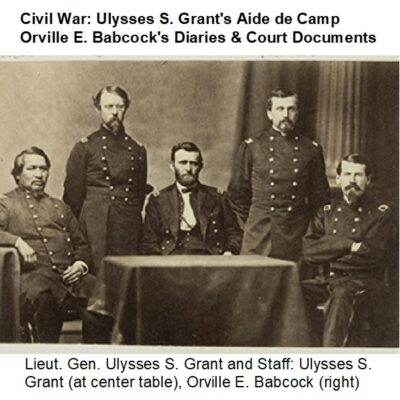
Civil War Ulysses S. Grant’s Aide de Camp Orville E. Babcock’s Diaries & Court Documents
$3.94 Add to Cart -
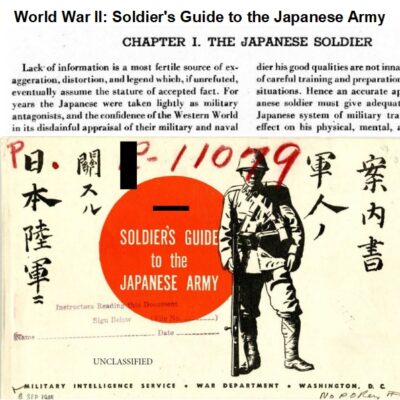

World War II: A Soldier’s Handbook on the Japanese Army
$3.94 Add to Cart -
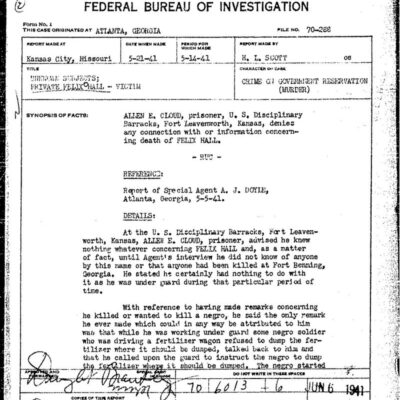
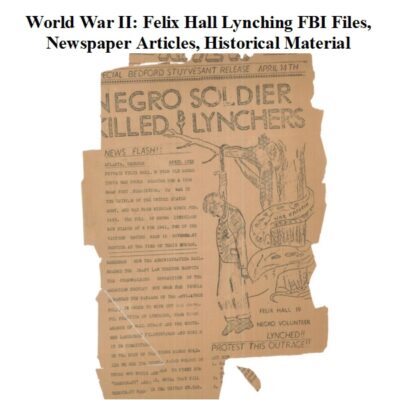
World War II: Felix Hall Lynching – FBI Files, Articles, Historical Records
$9.99 Add to Cart -
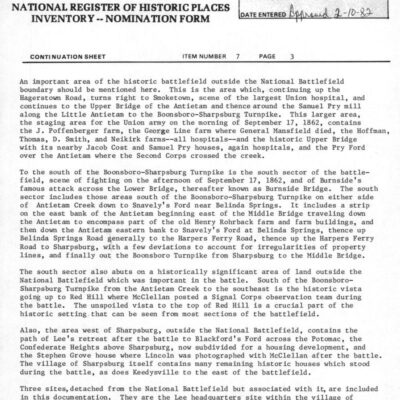

Civil War: Battle of Antietam (Sharpsburg) – National Park Service Archives
$9.99 Add to Cart